Wan Chain Long Text: How to learn business analysis
Author:Everyone is a product manager Time:2022.07.11
Edit Introduction: Business analysis is one of the very basic and important tasks for business analysts. The author of this article shared the specific method of learning business analysis. Detailed analysis of the concepts of business analysis, the basic differences between business analysis and data analysis, the problems that will be encountered in the process of business analysis, and the content of the definition of the problem. Let's learn it together. I hope it will be helpful to you.

1. Overview business analysis
What is business analysis?
Excerpt a section of 100 subjects: Business analysis refers to the analysis of economic benefits of the plan, and further determines whether it meets its corporate goals.
If it meets, the product concept can enter the product development stage. Including whether the expected sales, costs, and profits meet the company's expected goals; if they reach, this product concept can further develop to the product development stage.
The retail sales of specific commodities can be found in the commercial or consumer statistics announcement, effective purchase income, and total retail sales.
Does it sound complicated? If for novices, you may not understand this paragraph.
In fact, there is a more popular interpretation, which is to understand the literal meaning, divided into business and analysis, and business refers to a organized business and services required for customers.
Analysis is the understanding of the overall parts, factors and levels of the research object, and inspect each other.
That's a solution to find problems based on a business problem.
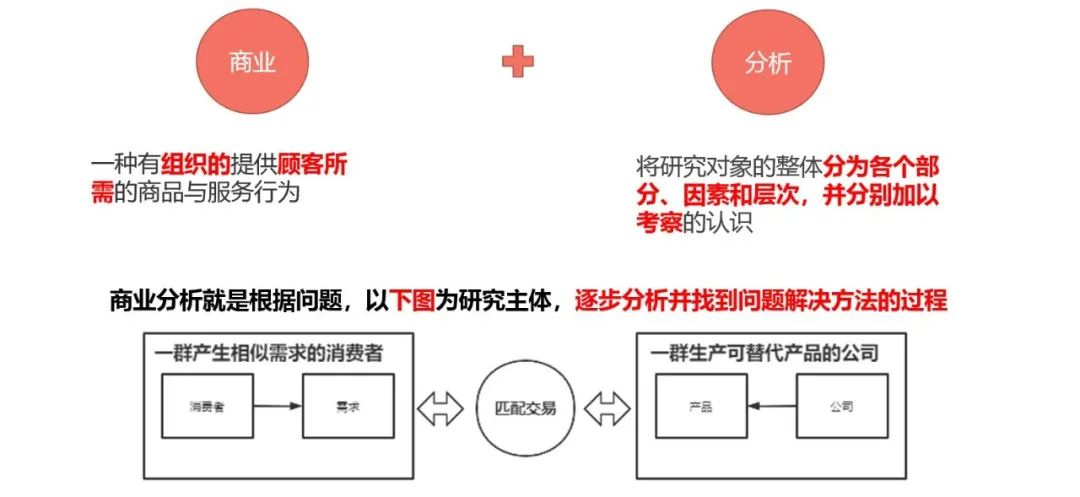
2. Business analysis vs data analysis
This topic should be the most confusing problem for everyone. If you want to understand in -depth understanding, you can refer to the article written before.
Because I am also transferred from data analysts to business analysts, I briefly introduce the basic differences between data analysis and business analysis from the perspective on both sides.
The first level: The source of demand will be different. When doing data analysis, the main source of demand is the personnel of the person in charge of the business department. When the business analysis starts, the source of demand will gradually transfer. It has become CEO and first -level leaders, and the boundary is relatively vague.
The second level: In the past, when doing data analysis, everyone is actually more common, such as conducting business analysis and operation analysis. In fact , Saving effort and scale.
Simple can be understood as the existing business optimization and re -optimization, changing places where the product is relatively bad to achieve standard performance.
When the business analysis is the case, the analysis objects have changed some. Often, sometimes some opportunities are not found by themselves. The angle of suggestions may become an industry/market/competitors and their own opportunities to analyze.
The perspective of specific suggestions may be different.
What specific behaviors are data analysis that can improve efficiency?
Business analysis may become: where can there be opportunities to improve in industry and market space now? How do we grasp it? If you want to go in, how to fight differently with some companies and opponents now? Can I find the possible weaknesses of their opponents, and even say how to manufacture the barriers to the industry after entering the market?
The result of data analysis may be the optimization of business, the possible result of business analysis may be the dividend of the industry, and so on.
The length of landing between the two is different. For example, it is now entering the industry early, and the industry has gradually begun to grow, so the timeliness of the dividend of the result is slightly longer. If it is said that it is a business module, it may bring the effectiveness of the effectiveness. Between 1 and 2 months.
The figure below is the comparison chart of the author's classification summary:

3. Learn the five major issues encountered by the business analysis meeting
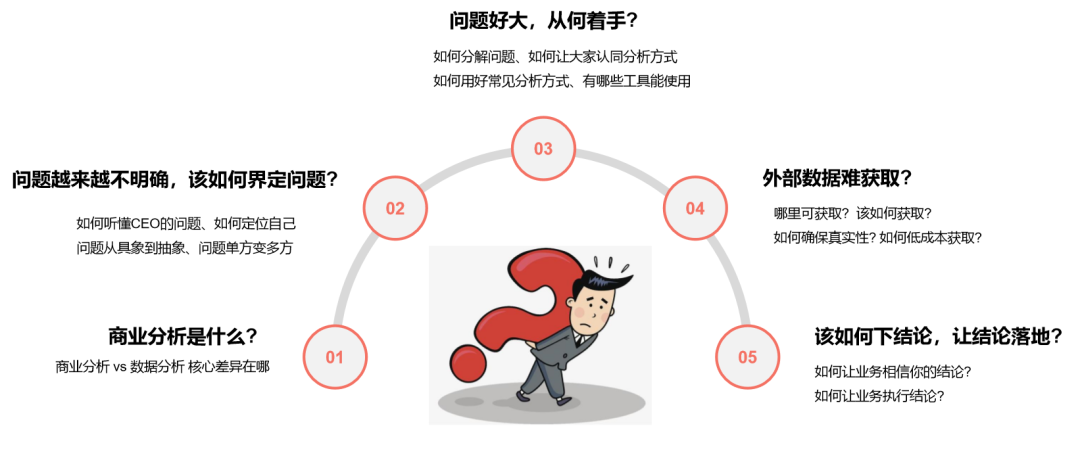
The first question, what is business analysis? Because we need to think about what value we can bring in the end, if the value cannot be measured exactly, it is difficult to do this. The second question, the question is not clear, how to define the problem? As the level of the demand party is getting bigger and bigger, the problems we accept will become increasingly unclear and wider. In this situation and scenario, how to improve your ability to define the problem allows you to analyze in one step in place. We need to think deeply. The third question, the question is very big, where do you start? Maybe the executives have clarified the problem, but his problem has become some problems between the company and the company. So how do you solve it? To solve the problem by splitting. The fourth question is difficult to obtain external data? Even if business analysts know how to do analysis, they will still encounter some data problems. After all, we usually study emerging industry opportunities. Most of the real situation data, you can't find it. The problem you face here is, how do you get external data? Or how can you ensure authenticity after getting it? How to reduce the cost of acquisition? Finally, I got these things, how do you let the result fall, the fifth question: How do you make the business party believe in your results? Believe in your conclusion, can the conclusion still run? The above is an overview of five issues. We will serialize the article. Everyone also sees the title of this article, which will gradually tell you the skills, the methods, tools, how to define the problems, how to define the problems, and solve the problem. There will be four serials in the article, and you can continue to pay attention. Fourth, start with the end -starting from the definition problem
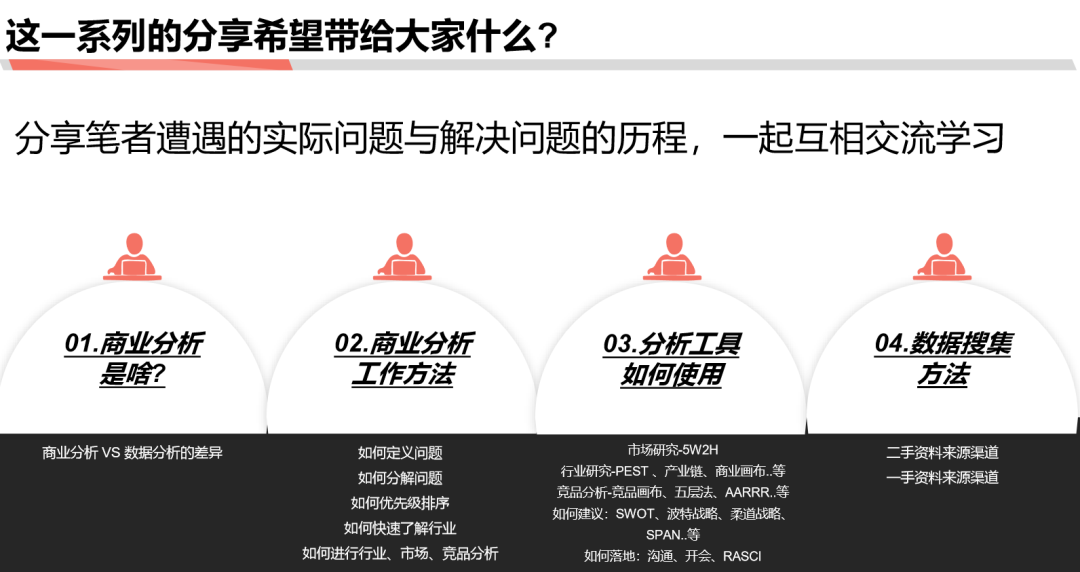
Why is it not about analysis methods and analysis tools in the first chapter, but how to define the problem?
Because if you do not have a good definition at the beginning, you cannot have a good analysis application.
In fact, the definition problem is a very critical node that is suitable for all the positions of our work and life.
1. Why define the question
If we do not figure out the ideals, we can analogize the same as the purpose of driving navigation without entering this.
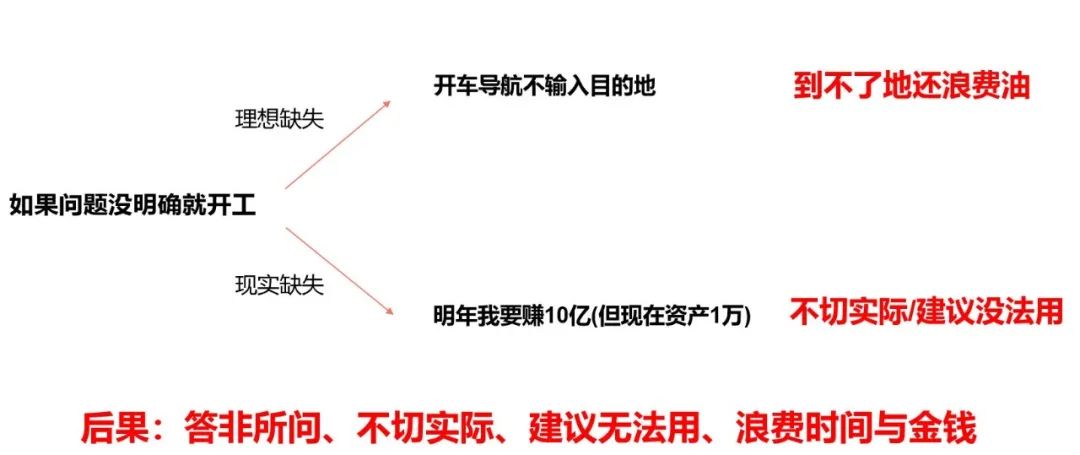
In the work, we often receive a lot of needs, but the other party does not clearly express the specific and successful standards, that is, we do not know the standards of doing things and doing well. Observe that many people exist like this: what is the problem of the specific goal, it starts to do nothing without defining anything, and waste a lot of time at the end. A very common problem.
The second problem is the lack of reality. For example, when I customize my problem, the actual situation is not considered.
Example: My ideal is to earn 10 million next year, but if my assets are now 10,000 or 100,000, then the two solutions that can be obtained are very different. If you do not know that the asset is 10,000 is 10,000, you are 10,000. The goal is 10 million. If the final scheme and suggestions are given, then it will directly lead to unrealistic things, and even say that the suggestion cannot be used.
Therefore, the definition problem is actually a part of establishing ideals and reality. In the process, in fact, the lack of ideal and lack of reality will lead to the corresponding conclusion: the answer is unrealistic.
2. Five major issues defined by the problem
What are the five problems that are often encountered by defining the problem?
First of all, the first question is not specific. For example, I have received the question given me most often, saying that you can find a 100 billion business opportunity within a week? This is actually relatively not specific.
The second question: the problem is too general and the scope is too large, for example, he may sell a medicine. I didn't say which direction is the medicine and which medicines should pay attention to, but it is expected to be produced in half a year.
Third question: Assuming that the problem of people who ask you for your needs have been clarified, but when you ask the problem, you have not considered the potential characters behind the problem with related interests.
The fourth question is to see the problem. Although the problem has been determined, there is still greater problems behind the problem.
Fifth, the demand is clear, but he is unwilling to pay costs for demand. The above is the five aspects of the most common problem in business analysis in business analysis.
1) Question 1: The problem is not specific
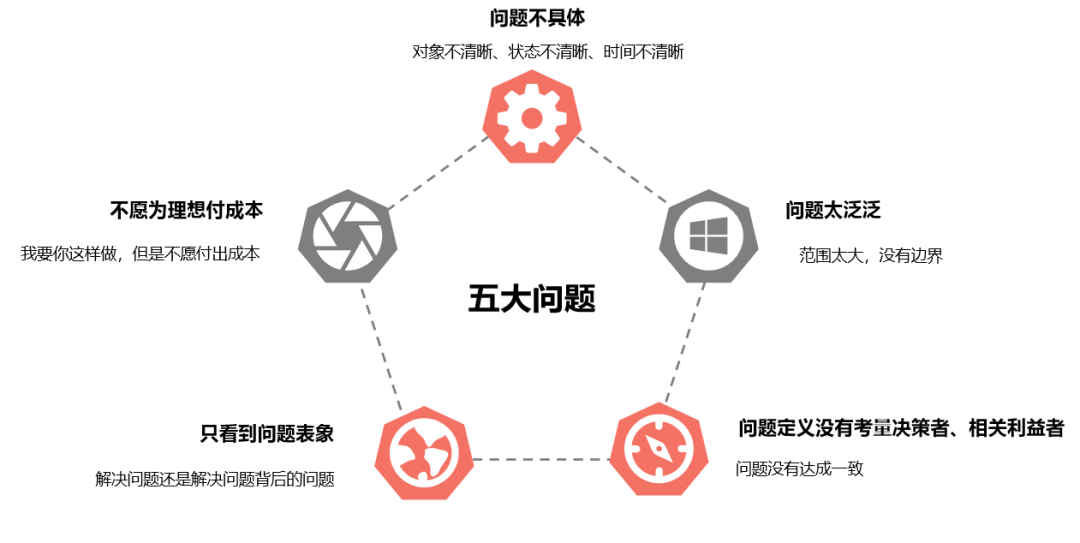
example:
I often encounter an example recently: I think the XX business is not good, you can analyze the reason.
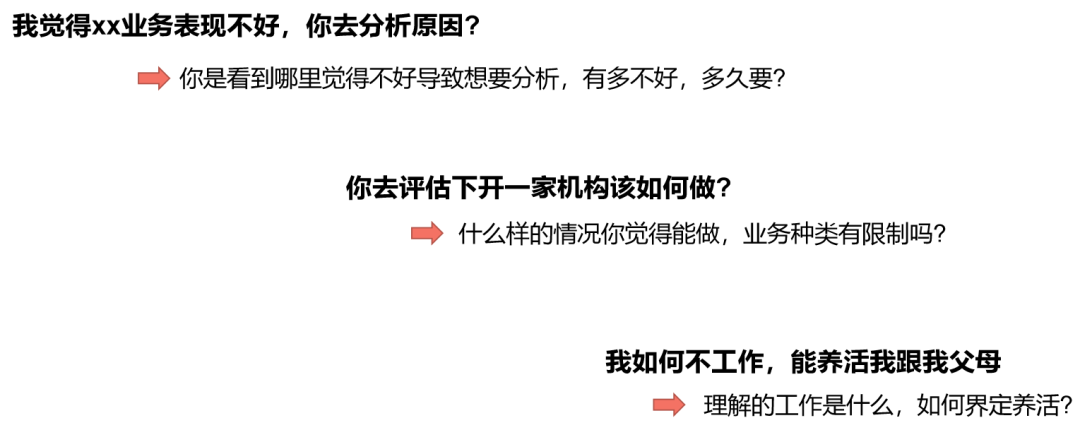
This is actually the problem that the problem is not very specific. For example, where is it not specific? First of all, where is this business bad? What is the business that causes your business and you feel bad and want to analyze. Then your badness refers to it? How bad, is it energy?
What is the time dimension of the reason for the reason? Then what is this reason? To what extent to. If you say that you are not very specific and do analysis directly, it is easy to waste a lot of energy and run off.
The second is that I encountered a problem: you go to evaluate what to do to open the organization? Under what circumstances do you think you can do it? What kind of do not do? Is there any restrictions on the types of institutions? This is also the problem.
Then in life, colleagues asked: How can I feed me and my parents without working. In fact, this problem is not specific. What is work? If you like and do not like, you can count the job. How can you support your parents? 2) Question 2: The problem is too general
example:
This kind of problem, for example, do you have the opportunity to evaluate the industry?
Usually, when the boss raises this question, behind the boss, he has seen a lot of industries. He must have some reason to ask for demand. Therefore, in general, you still have to look at the boss now asking the bottom of the question behind this question. logic. Because sometimes he does not say that he needs to observe and feel himself.

For example: The bosses often ask various problems. When I just work, I will feel that the boss is unreasonable, but as I grow older, I find that the boss is actually in his position, and what he sees is more vision and more. And most of the bosses have shares, the company's life and death are most related to them. So in fact, the bosses will be the most anxious.
He will actually be forced to see many upstream, middle reaches, downstream problems, and forced to see a lot of information. So the boss suddenly raised this question, sometimes it makes you feel stupid.
In fact, there are several reasons for this: First, you may not stand on his stand to understand him. Sometimes the boss is not very clear, whether his judgment is right.
He needed someone to help him use other angles to judge this matter. But in the whole process, the boss still has an expected answer.
In the process of defining the problem, if you can explore the expectations of the boss's expectations, this will be more targeted to surpass the expectations in his heart.
Let's talk about whether there is a chance to find a 1 billion business? Give me a conclusion a week. So are you focusing on the medicine and beauty industry? Or all the industries can, we have no chance of advantages, we can't see it? How do you think of the opportunity to define?
Solution:
For these two issues above, I recommend a tool Smart principle (reference below) to you:
This tool is actually a standard. Popularly, the problem is to use these five principles to clarify the problem.
These five principles are s (specific): not pan -general, there is a scope T (measured): can determine whether success or not, and try to measure it can be measured. With the status quo, it can be measured or as measured as possible. If you cannot determine this matter, you cannot understand the gap between the ideal and reality, which will lead to the unable to focus on the problem of the problem to solve the problem.
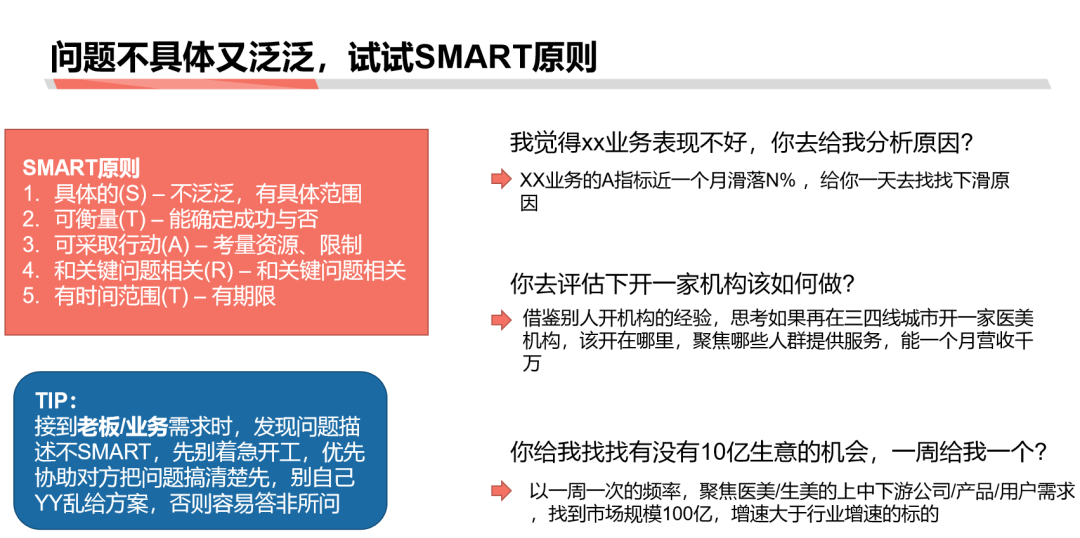
The consequence is that you have solved the problem, but the leader does not recognize A (can take action): Targeting the target R (related to key issues) that may be achieved by considering resources and restrictions: Usually the problem we receive is often the problem that the upstream leaders want to solve the problem. Next, a problem that is split.
But when we receive the problem, we do not necessarily know what the mother's problem is after the problem. Therefore, you need to dig out yourself. At the same time, you have to ensure the correlation between this problem and the mother's problem, and after you solve this problem, you can indirectly solve the mother's problem.
If you can't be sure that this matter will easily be offset. Even after the specific plan came out, it failed to meet the needs of the leader. T (time range): The description or limit on time is used, so we simply use the above problem with the Smart principle.
First of all, I think the XX business does not perform well. It can be disassembled into the XX business A indicator A in the last month. The reasons for the decline in the last month. Second, you go to evaluate how we open a organization.
So try to think about, do we learn from? Which city or area? What kind of institution is opened? Which crowd will be focused? Then do you think it is called success to open the institution? It is enough for a month's revenue, what about it?
Furthermore, do you find a chance to find a 1 billion business? At the frequency of once a week, you can focus on a certain piece and find the market size of 10 billion, and the industry growth is greater than the industry's growth rate. When these things are clear, our problem is relatively simple. So for the specifics, we can use the Smart principle to define the problem.
In addition, when receiving the needs of the boss, the problem description of the problem is not specific. Do not worry about starting first, to assist the other party to figure out the problem, do not give the plan by imagination, otherwise it is easy to answer these wastes at the same time.
3) Question 3: inconsistent understanding
example:
The first example: CEO feels that the performance of a team is slow, so do the team leader feel that it is slow. Furthermore, is the two people's cognition consistent with the slow reason? Can this problem be solved through MCN's external experience? So how can it be considered a problem? In fact, understanding is not complicated, but when this matter is said, everyone is consistent with the ideal of solving paths in reality.
The second example: How do I not work to support me and my parents? In fact, if you support the standard of feeding, you are set by you unilaterally, or you have discussed with your parents.
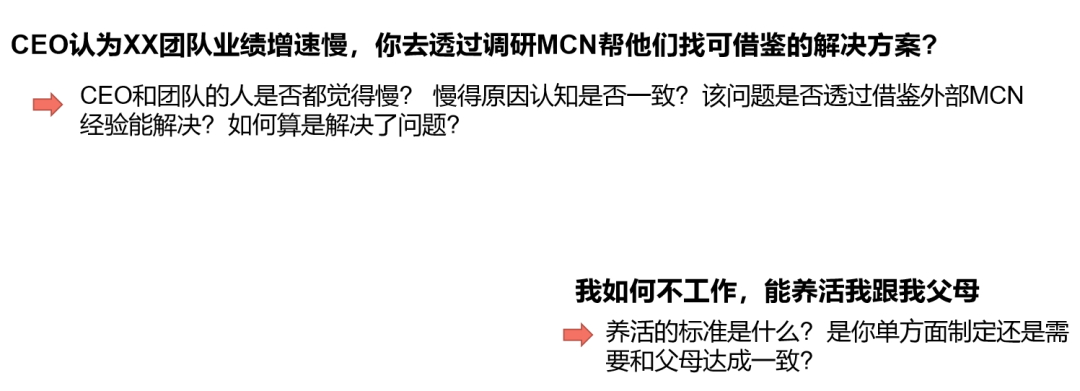
Therefore, the understanding of this problem is inconsistent, not only in work, but also often encountered in life. So how to achieve the problem?
Be sure to consider two types of roles.
First of all, the role of the one is the decision maker, the person who has the right to define the standard of success or the right of the current problem. If you have not reached an agreement with them, some people think that you do not meet the needs, then you do not meet the needs of this whole thing. The focus of these decisionists is to do things, but if you do not help them consider the interests of these many interesters, that is, you have not helped him to implement this matter well. So be sure to consider the opinions of the decision makers.
Furthermore is that related interests are often not alone, but a group of people. It is the person who executes this incident after the decision makers shoot. If you do not reach an agreement with them, even if the predicted result is good, they may affect the implementation of the target results.
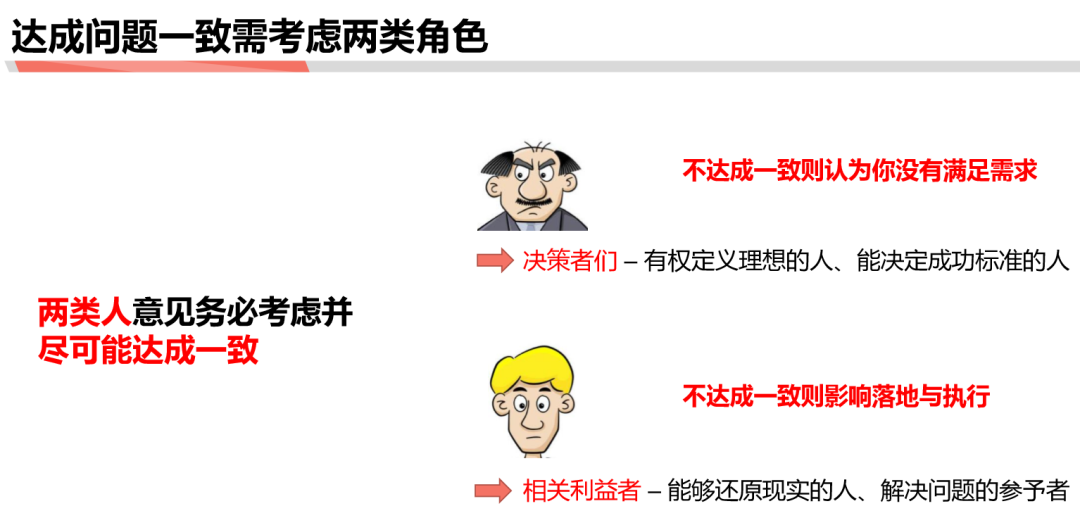
This is Yan Shen's interesting topic, when the problem involves more than three people:
example:
Related stakeholders and decisionists seem to be two, but in fact the problem will be more complicated. For example, in the case of dealing with a problem, in addition to the CEO, there are actually 78 managers under him, and even the finance will be included.
Therefore, the actual scene is: when you are going to identify this problem, you will find that everyone is talking about things differently. Then you will encounter the facts and situations of everyone's views and situations. What should you do?
Solution:
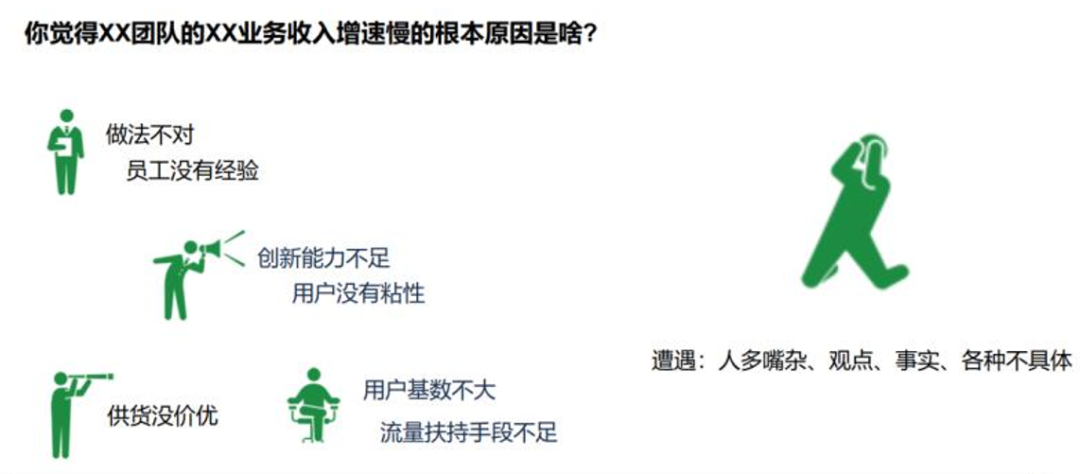
This method is not necessarily the best, but for me, the best use is to summarize through the pyramid structure.
The entire process is about three parts: first of all, you have to collect the facts of all parties as much as possible, and ensure whether the content is in line with the SMART principle mentioned above.
Then you can quickly use logic diagrams to sort out the logic relationship. You can use tools in your head. Finally, the two people who really influence the decision -making will be discussed, and the priority will be reached as much as possible: what is important and what is not important. What are the focus of analysis.
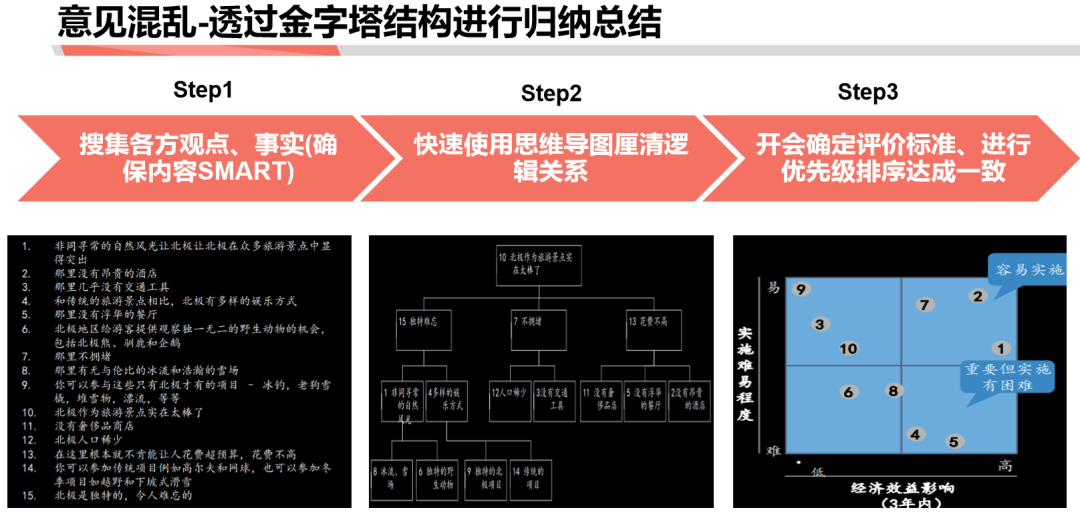
Example: The XX business performance does not improve, and the facts are collected and summarized.
First of all, collect the six points of facts: the first focus: the performance is not rising. 2345 is a point that requires strict attention throughout the collection process: first look up and go down, check whether the node is complete, and constantly check the overall structure.
How to start executing?
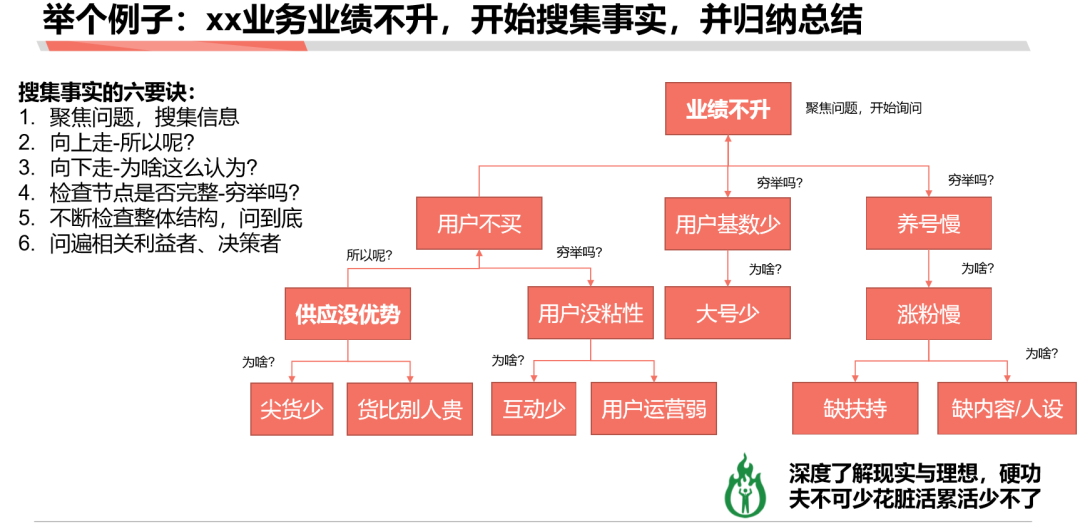
The process of not rising performance, first ask him what the reason. Perseverance with decision makers and stakeholders.
It is found that there is no advantage in the supply chain; why do you feel that there is no advantage in the supply chain, because there is less pickup, more expensive than others; what does the supply chain have no advantage? Users are dissatisfied. what else? The user is not sticky. What does it cause? Little interaction and weak user operations. Finally, check the nodes and do it poorly; gradually, the logic and facts of all decision makers and stakeholders are gradually structured, and then they are studied and then studied one by one. The entire subject is probably as above. Of course, these questions do not ask a person to get all the results. He asked many people to answer.
This is just the process of the first and second part. In addition, if you are more skilled, the whole process is actually simulated in your brain, and the author was familiar with it after practicing 30 to 40 times at the time. Anyway, the whole understanding and ideals, hard work, and dirty work cannot be saved.
After sorting out, to describe the process of fighting for you, sometimes the boss raises problems, and then defines one -to -one questions with the boss, and then began to find that the understanding of other related interests and bosses is inconsistent. Facts, then define the problem. Then open one to do sorting and voting, and re -modify the problem after the real agreement is reached.
The problem is defined, and then it is agreed with the boss, and finally because it is consistent. Therefore, everyone has a way to focus on a certain problem to solve it. When doing a business analysis Case, it will spend about 20%to 30%or even 40%of the problem definition.
Often, if you serve the CEO, after the problem is defined, many people will help you answer the question. However, often the problem defines, define problems, and helps everyone reach an agreement. In fact, no many people can do well.
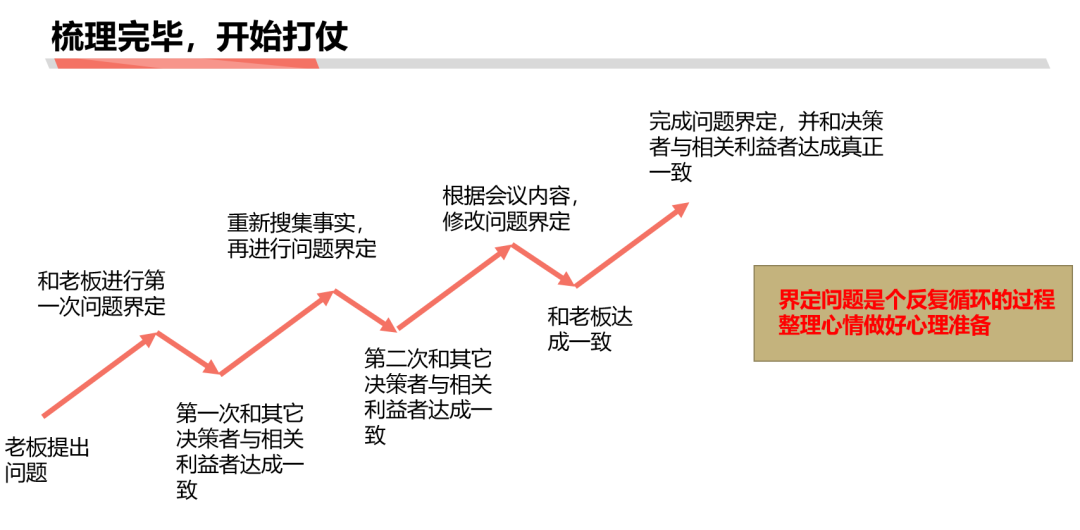
4) Question 4: Just look at the problem of the problem
example:
Let's enter the fourth problem that defines the problem: only see the appearance of the problem.
For example: the first question when the analysis was just started, "You go and see how the XX indicator".
Thinking: In fact, most people should answer this question, but what is determined to see what the purpose of this indicator is? What to determine? What is the problem caused by this question? Look at the indicator to solve the problem or the problem behind the problem? If it is the problem behind the problem, see if this indicator is appropriate? This is the first shallow appearance.
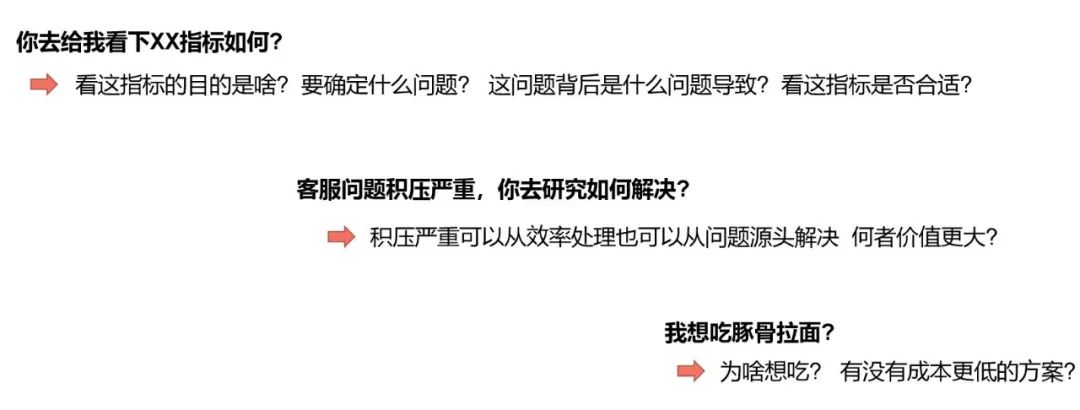
The second appearance, such as: the problem of customer service problems is very serious. How can you study how to solve it?
Thinking: The backlog can be solved from efficiency, and it can also be solved from the source of the outbreak of the problem. Which value is greater? If you are asking for a customer service manager, most of the solutions are improving the efficiency class, but if you ask the boss on the customer manager, then they may be more concerned about how you reduce the problem. Frequency of. Because the problems of customer service usually occur are usually caused by various processes. "Everyone is a product manager" case in the book: I want to eat dolphin ramen because you want to eat ramen or because you are hungry. So can you give you a lower solution? Probably such a process of understanding.
Solution:
How do we understand the ideal behind the boss and what he is thinking, that is, the five WHY method. The Five WHY method is used to use three tips: constantly asking, to split his elements according to his answers.
For example, for example, I want to eat KFC, why do you want to eat KFC because I am hungry. Isn't the bun? Give him a replacement method. If he walks, it may provide a cost -saving solution. If he does not work, you may need to give him another method.
Then he may say: I want to eat fried chicken, and then you will find that there are actually two constraints in it: fried and chicken.
First of all, you start to ask whether it is fried or chicken, and fried pork chops. In fact, during the whole process, if the buns are OK, you can solve it with a low -cost solution. If you find that this user is the demand of fried, you can you can Find the deep needs of users, then you will have more low -cost alternatives.
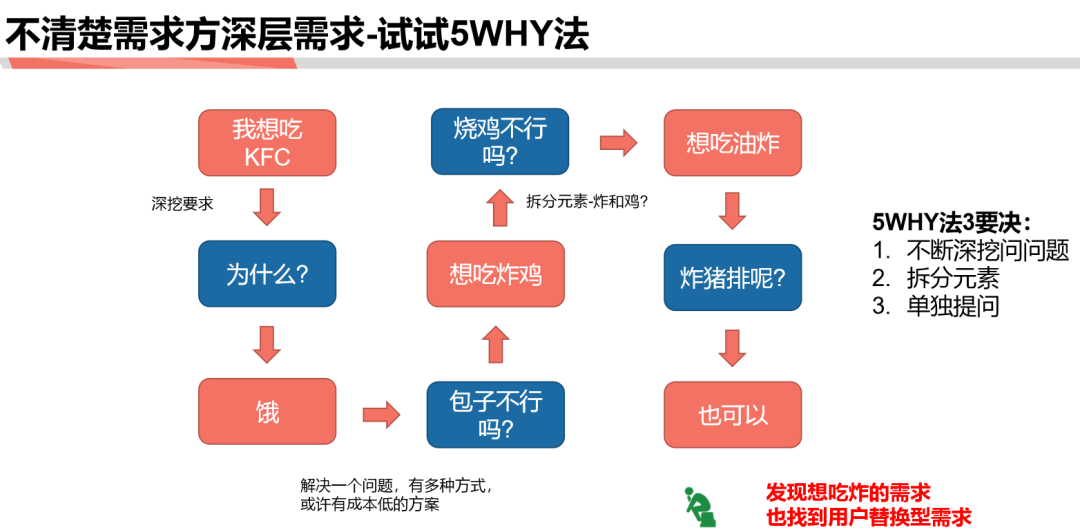
Three benefits of understanding deep needs:
We need to solve demand rather than requirements; may find a lower cost; solving deep demand can meet more people and greater value.
For example: When doing business managers, the most commonly encountered question is: Whether a certain business can do, we think about chatting.
In fact, behind this problem, there are several possibilities. First of all: it may let you evaluate whether it has a chance to do it?
Then analyze the market/industry and demand. There is also judging whether it should be done? Then it is necessary to perform a profit model, effect estimation, risk assessment, cost estimation and other behaviors.
What if it is to do and the path? Then you need to analyze competition, how to differentiate, how to land, and so on. If it is confirmed whether a certain piece can be done better, it may become product analysis, operation analysis and business analysis.
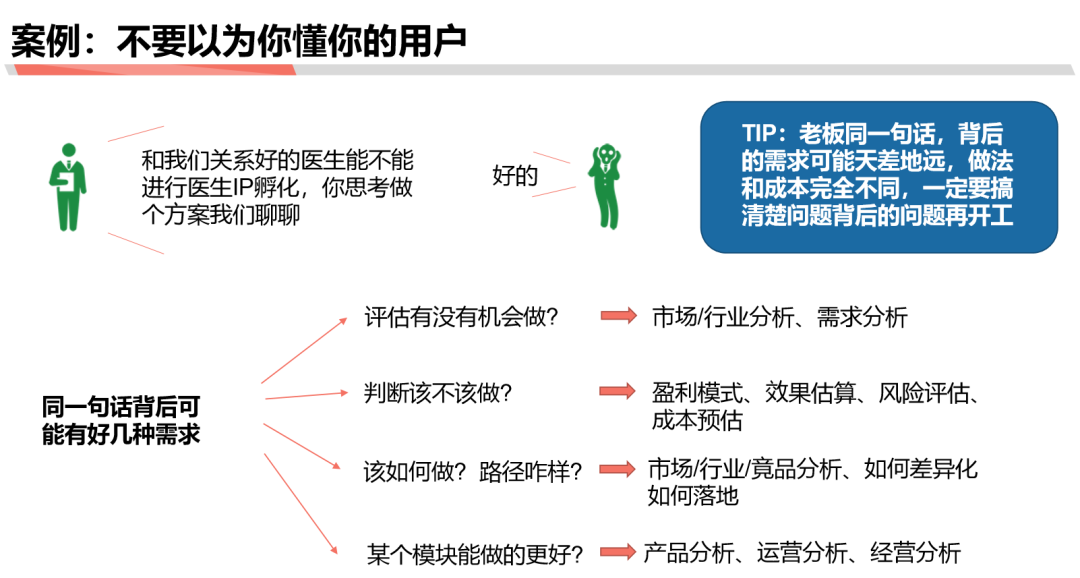
Therefore, these need to be figured out on the basis of defining the problem.
In fact, in the process of analysis, the cost of analysis behind the problem is completely different, so be sure to clarify what the result of the boss wants at the beginning.
In the same sentence of the boss, the needs behind it may be different, and the practices and costs are completely different. Be sure to figure out the problems behind the problem before starting.
5) Question 5: Unwilling to pay for ideals
example:
The first example: You can help me see the data. I told him: Which Kanban do you go to see? There is no need. This is the first need to pay for ideals. The second example: I need to know the changes in online sales of all competitors in time. Time may be within a week. I helped him take the count, and told him that the resources needed to be needed would not be done, and the timely demand disappeared. The third example: a product problem, I want to eat Michelin for free. The problem is that no one refuses, but is you still willing to eat if you pay? What is the reason? No one will want free things. But if there is a cost, you may not want it. The logic behind this incident is that even if you understand his needs and problems, you must be psychologically defined whether this demand is true or desire. What is demand? The demand is that I want to enjoy a certain meal, but I am willing to pay for it. Desire is that I want a certain meal, but if I want to pay, I don't need it.
Therefore, the real problem is not to solve the desire, but to solve the needs. Otherwise, no one is willing to pay for you, unless you are charity.
3. Define the summary of the above 5 issues
Finally, summarize these five issues with practice:
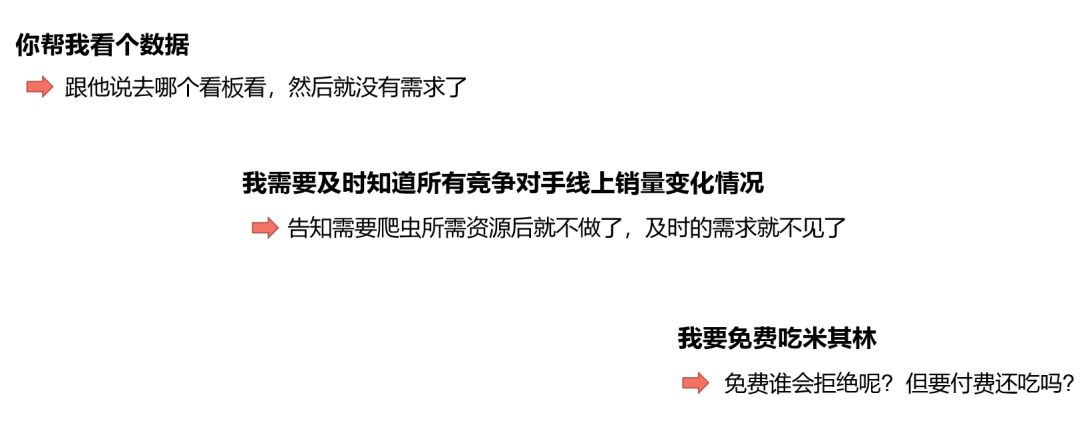
You can evaluate the chance of the medical beauty industry? That is, the problem is not too extensive. After the user's requirements are completed, the user does not use it at all. In fact, I only see the problem.
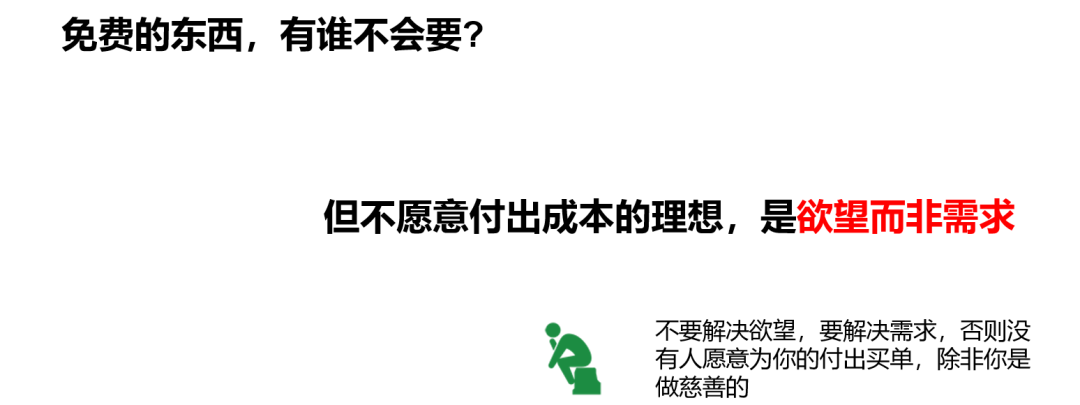
After the analysis, the boss answered or did not understand the business. It may be that they do not figure out reality and ideals.
The analysis concluded that the boss agreed, but the business executive resist. It is not those who do not consider related interests.
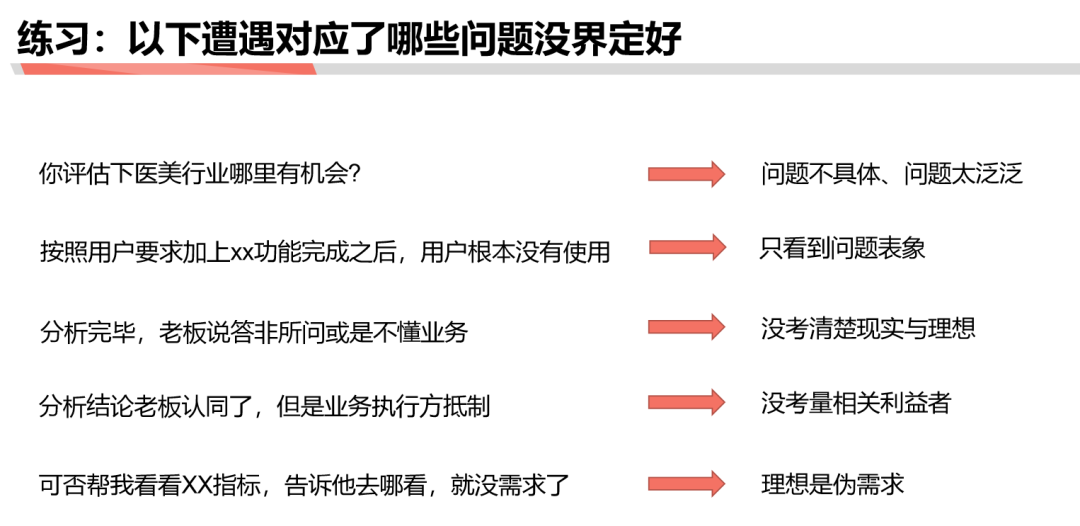
Do you help me see the XX indicator and tell him where to see, there is no demand. Ideal and pseudo -demand.
The above shared many methods, gathered the summary in the following 3 pictures:
figure 1
figure 2
image 3
Finally, I want to say that in actual work, it is difficult for you to do everything to the above perfection, but you must try to make it as clear as possible on the huge cost.
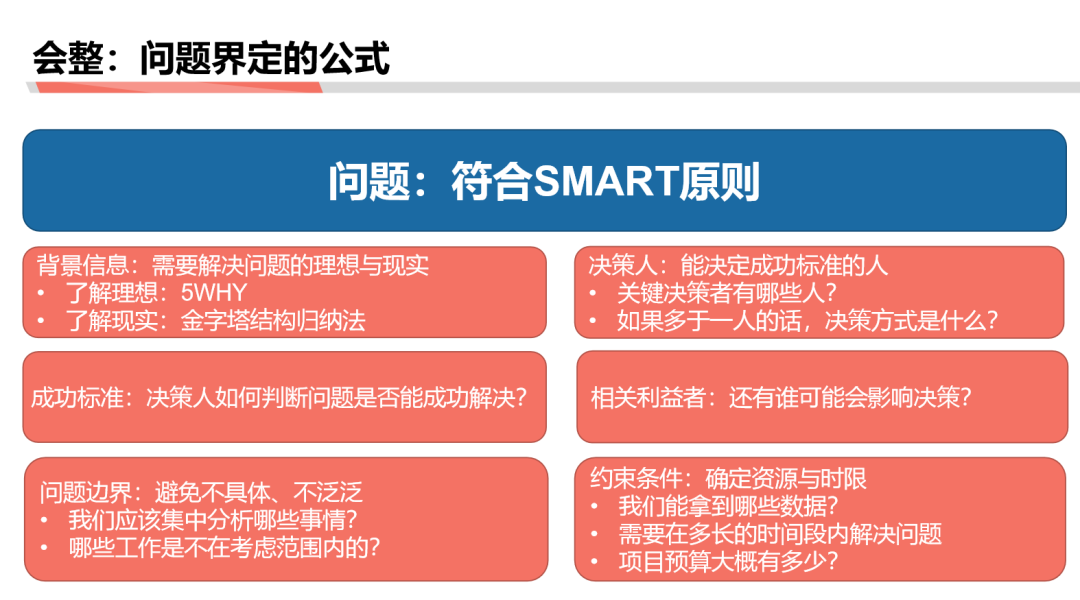
Because it does not matter if the cost of small costs fails, the cost of defining the problem is relatively small, and there is no major. But the kind of thing involving several departments or a lot of money is to be defined as much as possible, because it costs too much.
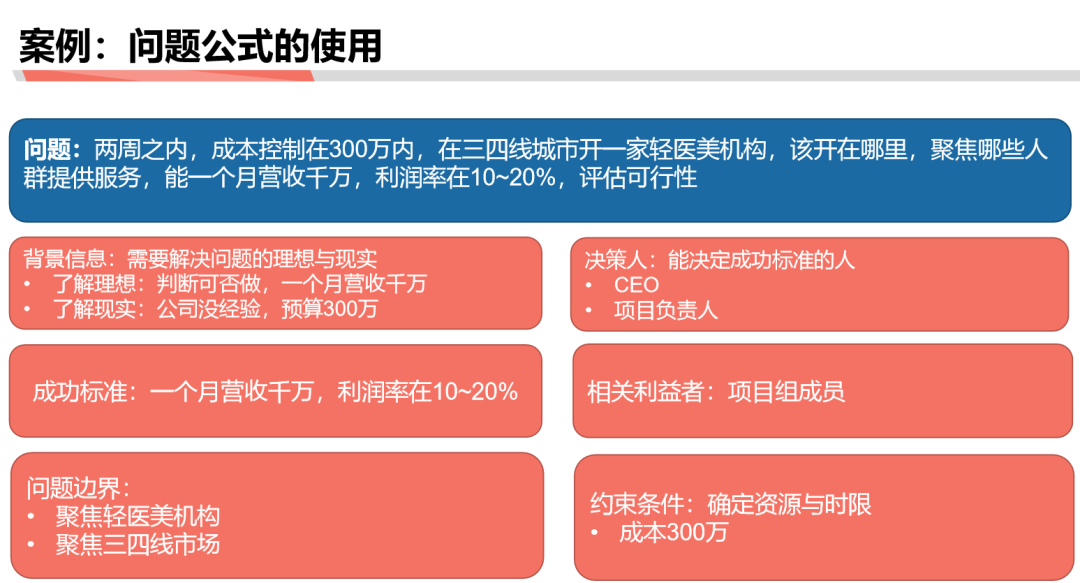
At the end of the article, I will think about the summary: If you are an employee, what should you do when you receive the problem?If you become a leader in the future, will you convey this kind of problem to your men?Therefore, it is recommended that you try to cultivate the habit of defining issues from today.Do not have to do everything well, but try to cultivate the habit of defining issues.

Conclusion: The veterans made up and moved the novice.
Author: Huang Jiahan, Blank Woman; WeChat public account: blank Woman (ID: kongbainvxia);
This article is published by @本 本 本 本 is a product manager. Reprinting is prohibited without permission.
The question map is from UNSPLASH, based on the CC0 protocol.
- END -
Walking in the front of the new bureau 丨 Zaozhuang: "The will of the change of change" has changed the butterfly change, and the beams and columns expand the modern industry

Zaozhuang is located at the Golden Node of the Beijing -Shanghai Greater Artery, a...
The "red line" of words and deeds, visiting Linyi every six months to Linyi implements dynamic management of advanced typical typical
On the afternoon of July 6, the Linyi Municipal Party Committee of the Communist Party of China held a press conference on the Implementation Measures for the Propaganda Work of Advanced Typical Tree